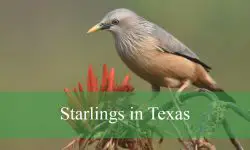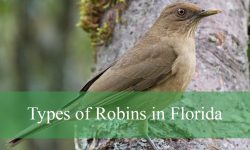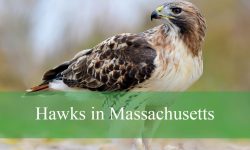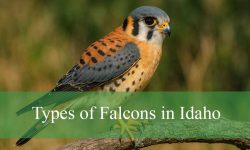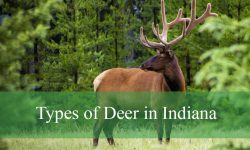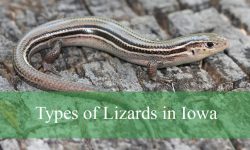Finches have been a quiet passion of mine for years. Their delicate size, cheerful songs, and surprising variety make them one of the most rewarding birds to watch. In Texas, they show up in all kinds of places—from backyards to mountain woodlands.
Each species has something special. The bold color of the House Finch, the soft golden glow of the American Goldfinch, or the unique bill of the Red Crossbill all add a new layer to the joy of birding. Some stay through the year, while others appear just long enough to make you miss them when they go.
This guide introduces 11 types of finches you can find across Texas. It includes pictures, identification tips, behavior notes, and feeding habits to help you recognize and appreciate each one. Whether you’re exploring a nature trail or simply watching your feeder, there’s always more to learn from these small, bright companions.
Different Types of Finches Found in Texas
House Finch (Haemorhous mexicanus)
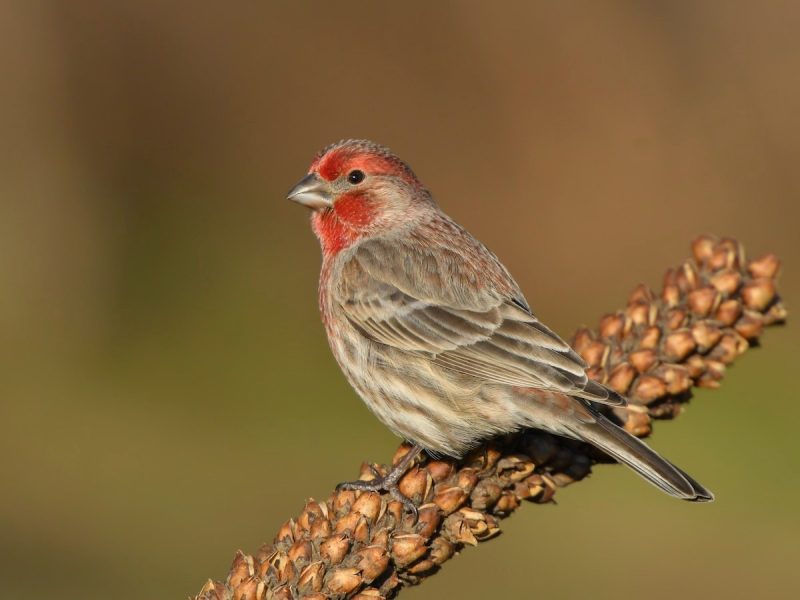
The House Finch is a small songbird commonly found throughout Texas, especially in urban and suburban areas. Males display bright red plumage on their heads and chests, while females have more subdued brown streaked feathers. They measure about 5 to 6 inches (13–15 cm) in length with a wingspan around 8 to 10 inches (20–25 cm), making them easily identifiable by their size and colorful markings.
House Finches are highly adaptable and often nest on buildings, trees, and shrubs near human habitation. Their behavior is social and active; they frequently gather in flocks, especially outside the breeding season. Their flight is direct and swift with rapid wing beats. The song of the House Finch is a series of cheerful, warbling notes, sometimes described as a cascading, jumbled melody.
In terms of diet, House Finches primarily feed on seeds, including those from weeds, grasses, and garden plants, but they also consume fruits and occasional insects. They are often seen visiting backyard feeders, especially favoring sunflower seeds. Breeding occurs from spring through summer, where females build cup-shaped nests in sheltered spots and lay 2 to 6 eggs. Both parents share feeding duties.
House Finches thrive in a wide range of Texas environments from city parks and residential areas to open woodlands and deserts. Their adaptability to different habitats and diets has helped them become one of the most widespread finches in the state, making them a common and beloved backyard bird.
Purple Finch (Haemorhous purpureus)
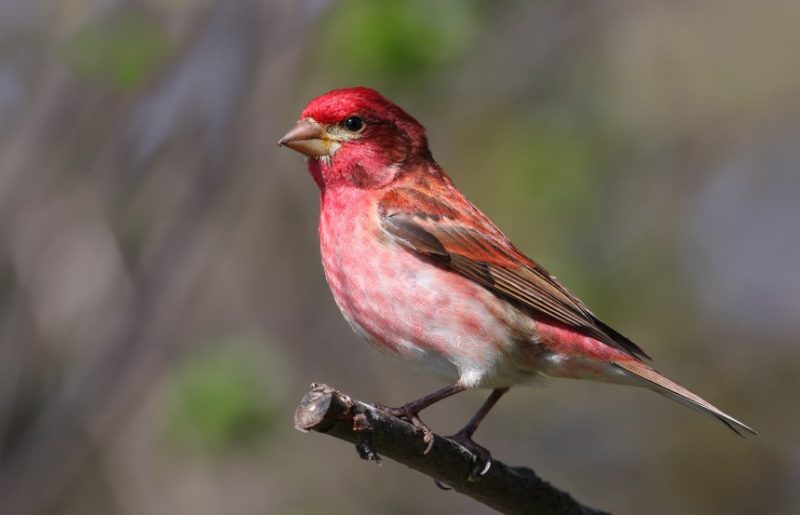
The Purple Finch is a medium-sized finch with a distinctive raspberry-red coloration covering the male’s head, breast, and back, while females and juveniles are brown and heavily streaked. These birds measure approximately 5.5 to 6.3 inches (14–16 cm) in length with a wingspan near 9.8 inches (25 cm). Their robust beak is adapted for cracking seeds, a staple in their diet.
Purple Finches prefer woodland edges, coniferous forests, and sometimes suburban parks in Texas. They are less commonly seen in urban areas compared to House Finches but still present during migration or winter. Their behavior is somewhat shy, often foraging quietly in trees or shrubs. Their song is a rich, warbling melody consisting of musical phrases and pleasant whistles.
Feeding mainly on seeds from trees such as pines and birches, they also consume berries and insects during breeding season to supplement protein needs. They are known to visit backyard feeders but are less frequent visitors than some other finch species. Nesting takes place in conifers or deciduous trees, where the female builds a neat cup nest and lays about 3 to 5 eggs.
Purple Finches migrate to Texas primarily during the winter months, with some residents in the northern parts of the state. Their preference for forested habitats means they are more common in the eastern Texas regions where such environments prevail.
Cassin’s Finch (Haemorhous cassinii)
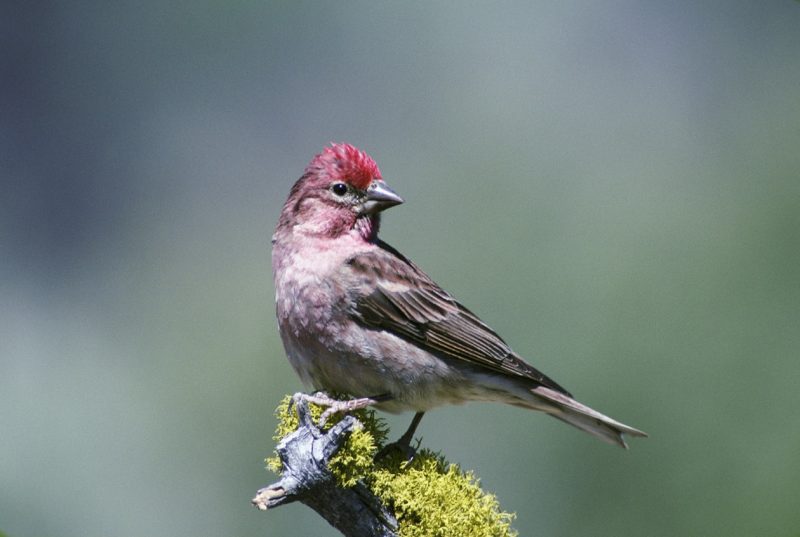
Cassin’s Finch is a striking finch native mostly to western North America, but it occasionally appears in Texas during migration. The male displays a bright rose-red crown, throat, and chest, contrasting with brown-streaked flanks, while females are brown with streaks and lack red coloring. They measure about 6.3 inches (16 cm) long with a wingspan close to 10 inches (25 cm).
This finch prefers montane pine forests but can be found in shrubby habitats during migration in Texas. Cassin’s Finch is often shy and elusive, feeding high in conifers and rarely descending to ground level. Its song is a series of musical warbles and trills, somewhat similar to the Purple Finch but less variable.
Diet consists mainly of seeds from conifers, weeds, and grasses, supplemented by insects during the breeding season. They are less likely than other finches to visit backyard feeders. Breeding involves building a cup-shaped nest in conifer trees where the female lays 3 to 5 eggs.
Cassin’s Finch is an uncommon visitor to Texas, seen mostly in western parts during migration seasons. Their presence is often tied to coniferous forests and mountainous regions, which are sparse in Texas but available in some western areas.
Lesser Goldfinch (Spinus psaltria)
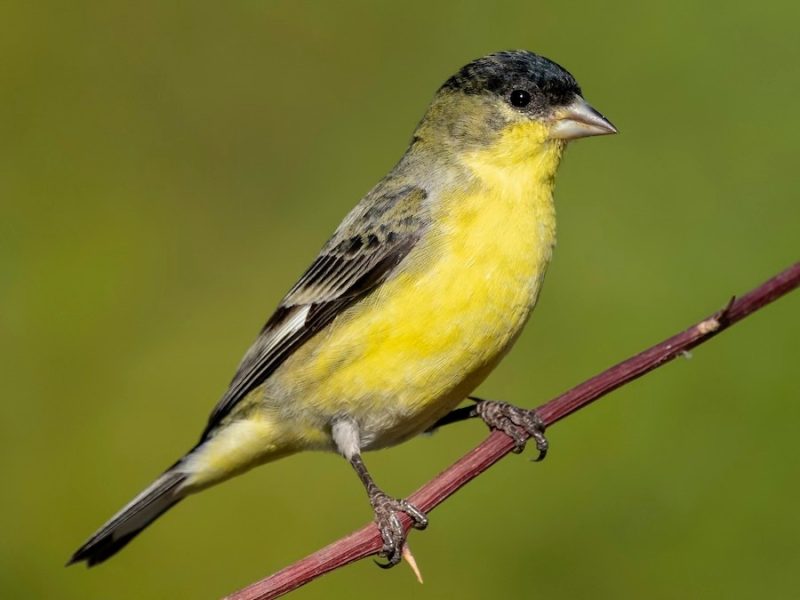
The Lesser Goldfinch is the smallest finch in Texas, measuring about 4 to 4.5 inches (10–11.5 cm) with a wingspan of 7.5 to 8.5 inches (19–22 cm). Males have shiny black heads and backs with bright yellow underparts, while females are duller with olive-green coloring replacing black. This contrast makes them fairly easy to identify.
Lesser Goldfinches are highly adaptable and commonly found in open woodlands, brushy areas, gardens, and along roadsides across Texas, especially in the southern and western parts. They often feed in small flocks, flitting quickly from branch to branch. Their song is a rapid, twittering series of warbles and trills.
Their diet mainly consists of small seeds from weeds and grasses, but they will also eat berries and insects. They are frequent visitors to backyard feeders, especially those offering nyjer and sunflower seeds. Nesting happens in shrubs or low trees with a neat cup nest made of plant fibers; females lay 3 to 6 eggs per clutch.
Lesser Goldfinches thrive in warm and dry habitats, making Texas’ varied environments—from deserts to woodlands—ideal for their survival and reproduction.
American Goldfinch (Spinus tristis)
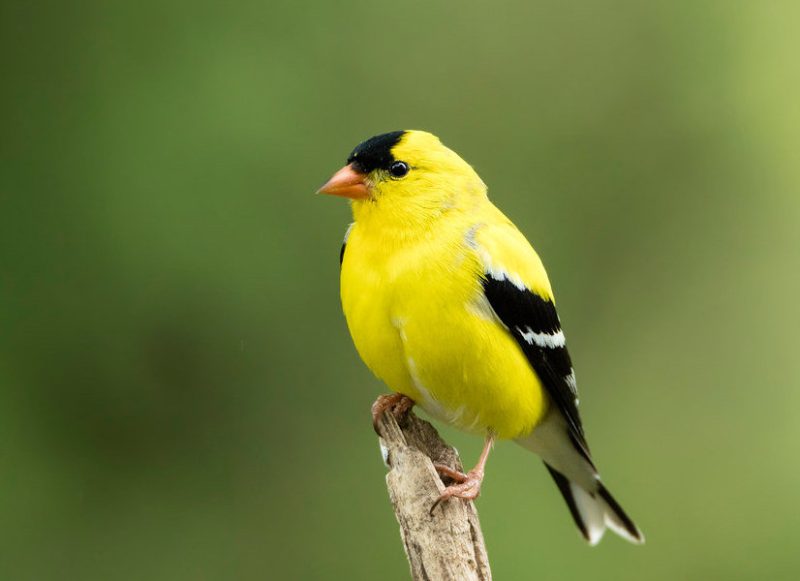
The American Goldfinch is a vibrant finch known for its bright yellow breeding plumage in males, contrasted with olive-yellow backs and white wing bars. Females are paler and duller but still show yellow tones. Adults measure around 4.3 to 5.1 inches (11–13 cm) long with a wingspan of 7.5 to 8.7 inches (19–22 cm).
In Texas, American Goldfinches prefer open fields, meadows, and areas with abundant thistle and sunflower plants. They are often seen in flocks outside the breeding season, moving actively among flowers and seedheads. Their flight is undulating and buoyant. The song consists of a cheerful, twinkling warble interspersed with trills and buzzes.
These finches specialize in feeding on small seeds, especially from composite flowers like asters and sunflowers. They also consume tree seeds and occasionally insects during the breeding season. They readily visit backyard feeders for nyjer and sunflower seeds. Nesting occurs late in the season, with females building nests lined with thistle down and laying 4 to 6 eggs.
American Goldfinches are well-adapted to Texas’ diverse habitats and are particularly abundant in areas that provide plentiful seed sources and open spaces for feeding and breeding.
Pine Siskin (Spinus pinus)
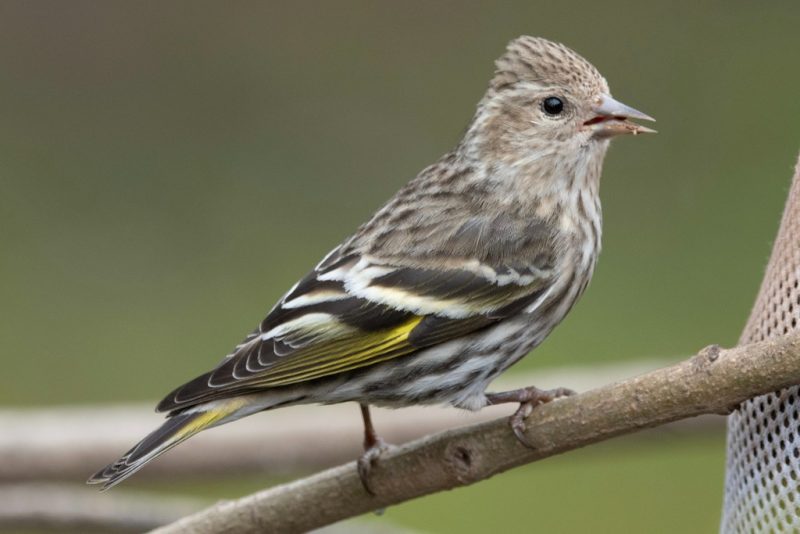
The Pine Siskin is a small finch measuring about 4.5 to 5 inches (11.5–13 cm) in length with a wingspan of approximately 8 to 9 inches (20–23 cm). They have streaky brown and white plumage with subtle yellow markings on the wings and tail, making them less conspicuous than other finches. Their slender, pointed bill is well adapted for extracting seeds from conifers.
Pine Siskins are often found in coniferous and mixed forests, but in Texas, they appear mainly during the winter months when they migrate from northern forests. They travel in flocks, sometimes mixing with other finch species. Their song is a high-pitched, rapid, and somewhat buzzy warble interspersed with sharp calls.
Their diet primarily consists of seeds from conifer cones, weeds, and grasses, although they will consume some insects during breeding. They also visit backyard feeders, especially for nyjer and sunflower seeds. Nesting takes place in conifers where the female builds a cup-shaped nest, laying 3 to 5 eggs.
Pine Siskins are irregular visitors to Texas, mainly seen in the northern and eastern parts during winter irruptions. Their presence depends largely on food availability in their usual northern habitats.
Lawrence’s Goldfinch (Spinus lawrencei)
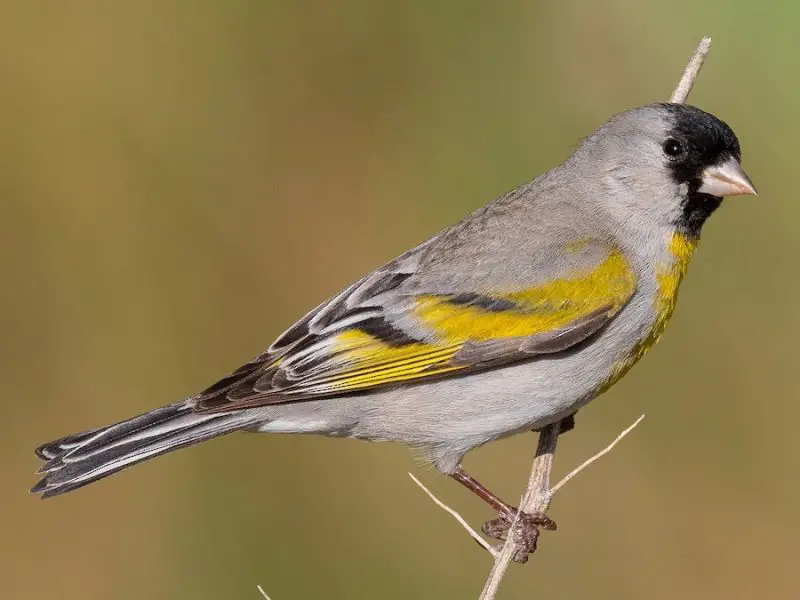
Lawrence’s Goldfinch is a small and somewhat elusive finch measuring about 4.7 inches (12 cm) with a wingspan around 7.9 inches (20 cm). Males display pale yellow underparts with a black face mask and grayish back, while females are duller with less distinct facial markings. This subtle coloration helps them blend into dry shrublands.
Primarily a resident of California and parts of the southwestern U.S., Lawrence’s Goldfinch occasionally appears in southern Texas during rare migration or dispersal events. They prefer arid scrub and chaparral habitats. Their behavior is somewhat secretive, often feeding in small groups.
Their diet is mainly seeds from weeds, grasses, and shrubs, supplemented by insects during breeding. Their song is a soft, musical warble with varied trills and phrases. Nesting occurs in low shrubs with the female constructing a small cup nest and laying 3 to 4 eggs.
While very uncommon in Texas, sightings of Lawrence’s Goldfinch have been reported in southern regions during certain years, often linked to environmental factors influencing their range.
Black-headed Grosbeak (Pheucticus melanocephalus)
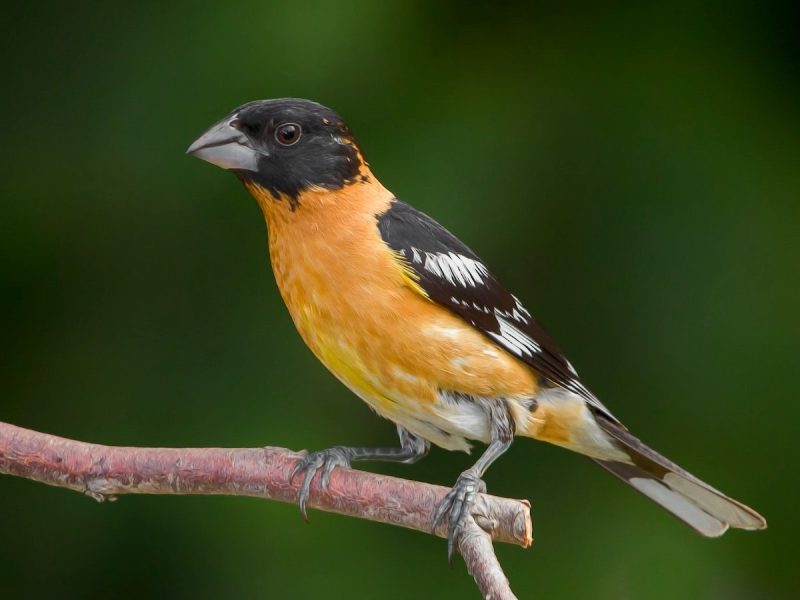
Though technically a grosbeak, this bird is closely related to finches and is often grouped with them. The Black-headed Grosbeak measures about 7.5 inches (19 cm) in length with a wingspan of 11 to 12 inches (28–30 cm). Males have striking orange underparts, a black head, and white patches on wings; females are more subdued with brown and streaky coloring.
In Texas, they are most commonly seen during migration, especially in the western part of the state. They inhabit woodlands, riparian areas, and brushy habitats. Their behavior is calm and deliberate, often foraging in trees and shrubs. Their song is a rich, melodious warble with musical phrases.
Their diet is varied, including seeds, fruits, and insects. They are especially fond of seeds from sunflowers and other plants and often visit feeders. Nesting occurs in trees or large shrubs, with females building cup nests and laying 3 to 5 eggs.
Black-headed Grosbeaks play an important role in seed dispersal and insect control, and though less common than other finches in Texas, they add a splash of color during their migrations.
Evening Grosbeak (Coccothraustes vespertinus)
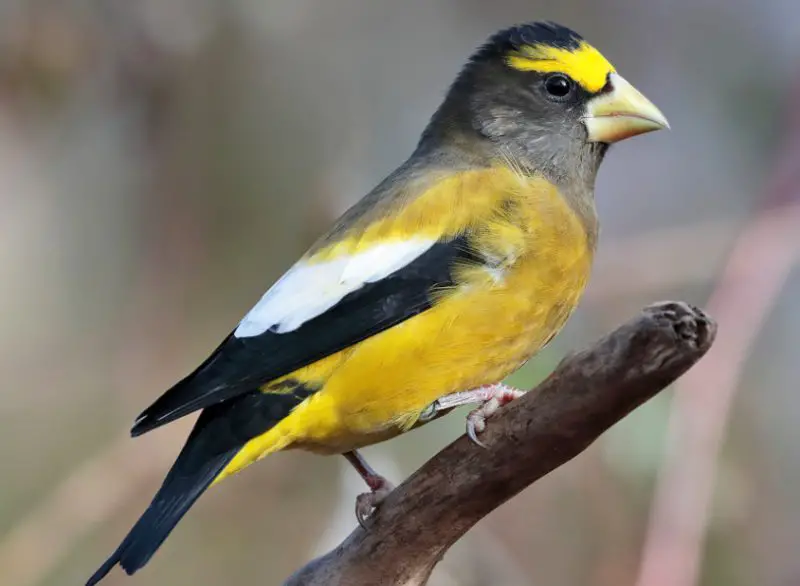
The Evening Grosbeak is a large, stocky finch-like bird, measuring around 7.5 to 8.3 inches (19–21 cm) with a wingspan of about 12 to 14 inches (30–36 cm). Males have bright yellow bodies, black heads, and white patches on wings, while females are duller with grayish heads. Their massive, conical bills are perfect for cracking tough seeds.
They are primarily northern birds, rarely seen in Texas except during winter irruptions when food is scarce farther north. Evening Grosbeaks favor mature coniferous forests and occasionally visit feeders during these irruptions. They are social, forming large flocks outside the breeding season.
Their diet includes seeds from conifers, berries, and insects. Their calls are loud and harsh, contrasting with their melodious but brief song. Nesting takes place high in conifers where females lay 3 to 4 eggs in well-built nests.
Though uncommon in Texas, Evening Grosbeaks are a fascinating sight during winter when they appear sporadically in the state.
Red Crossbill (Loxia curvirostra)
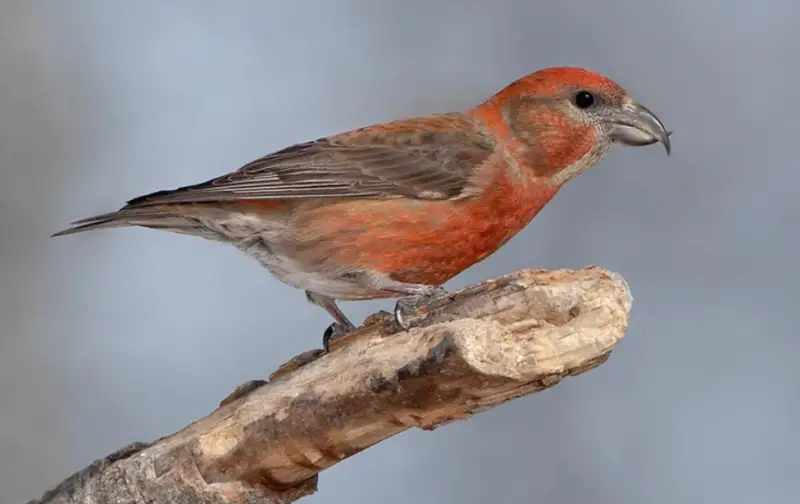
The Red Crossbill is a medium-sized finch, about 6 to 7 inches (15–18 cm) in length with a wingspan of approximately 9 to 11 inches (23–28 cm). Males are usually bright red or orange with dark wings, and females are greenish or yellowish. Their most notable feature is the crossed tips of their thick bills, uniquely adapted to pry seeds from conifer cones.
These birds prefer conifer forests and are highly nomadic, moving widely in search of food. In Texas, they are rare and mostly seen during irruptions or migration, particularly in pine forests in the east and west. Their behavior is energetic and acrobatic as they cling to cones.
Their diet consists almost entirely of conifer seeds, which they extract expertly with their crossed bills. Their calls are nasal and chatter-like, and their song is a complex, musical series of whistles and trills. Nesting usually occurs in conifers, where the female lays 3 to 5 eggs.
The Red Crossbill’s presence in Texas is irregular and tied to food availability in northern forests, making sightings a special treat for bird watchers.
White-winged Crossbill (Loxia leucoptera)
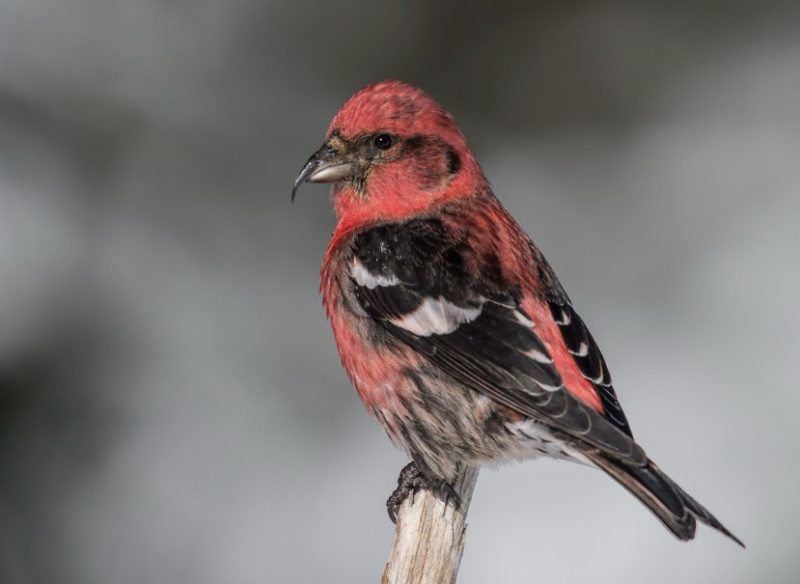
The White-winged Crossbill is similar in size to the Red Crossbill, measuring about 6 inches (15 cm) long with a wingspan near 9.5 inches (24 cm). Males are rose-red with distinctive white wing bars, while females are yellowish-green with the same wing markings. Their crossed bill tips are key for extracting conifer seeds.
They inhabit boreal conifer forests and rarely reach Texas, only appearing during irruption years when food is scarce in their northern range. When present, they are found in conifer stands and mixed woodlands. Their behavior is social, often seen in flocks feeding actively.
Their diet is highly specialized, focusing on seeds from spruce, fir, and pine cones. Their calls are sharp and buzzing, and their song is a pleasant series of warbles and whistles. Nesting happens in dense conifers where females lay about 4 eggs.
White-winged Crossbills are very rare in Texas, but their occasional visits provide unique birding opportunities in suitable forested habitats.
FAQs About Finches in Texas
What is the most common finch species in Texas?
The House Finch is considered the most common finch species in Texas. It thrives in urban, suburban, and rural environments and is frequently seen at backyard bird feeders year-round.
Do finches migrate through Texas?
Yes, some finch species migrate through or winter in Texas. Pine Siskins, American Goldfinches, Purple Finches, and even Red Crossbills can be seen in Texas during migration seasons or irruptive winters.
What do finches eat in Texas?
Finches in Texas primarily eat seeds from plants like sunflowers, thistles, and grasses. They also consume berries and insects, especially during breeding season. At feeders, they are drawn to nyjer seed, millet, and black oil sunflower seeds.
When is the best time to see finches in Texas?
Finches can be seen throughout the year in Texas, but winter and early spring are the best times to spot a variety of species, especially migratory ones like the Pine Siskin and American Goldfinch.
Where should I place feeders to attract finches?
To attract finches, place feeders in quiet areas near shrubs or trees, which offer cover and nesting opportunities. Use tube feeders filled with nyjer seed or sunflower chips, which are favorites of many finch species.
Do finches nest in Texas?
Yes, several species including House Finches and Lesser Goldfinches nest in Texas. They often build their nests in trees, shrubs, or even on building ledges in suburban areas during spring and summer.
Are crossbills considered finches?
Yes, both Red Crossbills and White-winged Crossbills are part of the finch family (Fringillidae). Their distinctive crossed bills and reliance on conifer seeds make them unique among finches.
Are finches aggressive toward other birds?
Most finches are social and non-aggressive, but they can show mild territorial behavior at feeders, especially during the breeding season. However, they usually tolerate the presence of other small birds.
Can I find finches in the deserts of Texas?
Yes, species like the Lesser Goldfinch are well-adapted to arid environments and are commonly found in desert and scrub regions of western and southern Texas.
Are any finches rare in Texas?
Yes, Lawrence’s Goldfinch, Evening Grosbeak, and White-winged Crossbill are rare or accidental visitors in Texas. Their presence is often unpredictable and tied to irruptions or changes in food availability.

